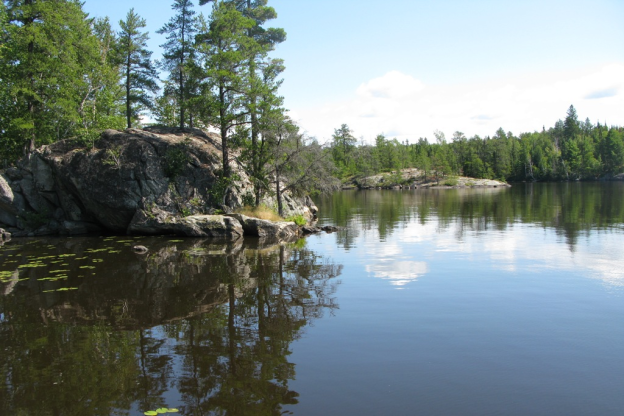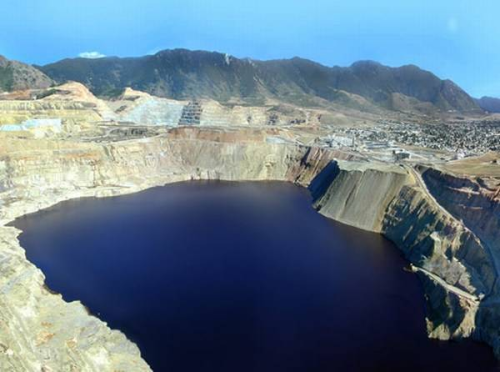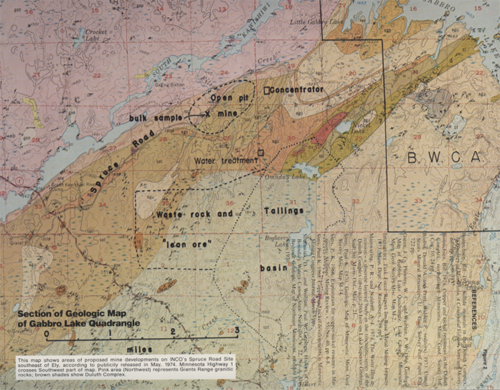
What lies – not very far – beneath
Discussions about the proposed new sulfide mines in northern Minnesota always talk about an open pit mine at Hoyt Lakes and and an “underground” mine near Ely. But the “underground” appellation isn’t accurate, or not entirely so, anyway. And when he gets out of Dodge to talk about it, Duluth Metals president Vern Baker (hometown Reno, Nevada) will say as much. In a web newspaper called Northern Ontario News, Baker is quoted as saying to a Canadian business group that the Twin Metals Project will only be “predominantly” underground.
But Baker expects big things from Twin Metals Minnesota (a joint venture between Duluth Metals, a Canadian company (which seem a little misleading, don’t you think, kids?), and Chile’s Antofagasta plc):
Baker predicts the Twin Metals Minnesota (TMM) complex . . . will become one of the world’s major mining districts over the next five to 10 years because of the massive potential tonnages and the types of ore to be found there.
Baker said to the group he spoke to in Sudbury, Ontario:
We have a huge opportunity just in the quantity of metal that’s available,” said Baker, who puts TMM on the same scale as some of the largest copper mines in South America. “It’s got some very distinct similarities to Sudbury and some very distinct differences.
And indeed, in South America there are some really big copper/sulfide mines. In fact, the biggest one is in Chuquicamata, in the Antofagasta Region of Chile. You really must follow the link to see a photo of this sucker.
And Antofagasta? Hmmmmmm. That sounds familiar. Of course! It’s the name of Duluth Metals’ Chilean sidekicks.
Baker says Twin Metals Minnesota mine will be “predominantly” underground. But here’s how these things work:
Just outside Butte, Montana lies Berkeley Pit: a pit filled with greenish poison a mile and a half wide and over a third of a mile deep. It was once a thriving copper mine where millions of tons of copper ore, silver, gold, and other metals were extracted from the soil.
When underground mining became too costly in the 1950’s, Berkeley Pit became an open pit mine. As the mine grew bigger and deeper, groundwater began to seep into the pit, and pumps had to be installed to keep it from slowly flooding.
Thirty years later, the mine was so exhausted that it was no longer profitable. The pit was abandoned and the water pumps were shut down. Without the pumps, rain and groundwater gradually began to rise in the pit, leaching out the metals and minerals in the surrounding rock. The water became as acidic as a lemon, creating a toxic mixture of heavy metal poisons such as arsenic, lead, and zinc. No fish live there, and no plants line the shores. There aren’t even any insects around, only some rare kinds of microorganisms survive in the toxic water. The Berkeley Pit had become one of the deadliest places on earth. The iron-rich water near the surface is reddish, yielding to a vibrant lime-green hue not far below the surface, where copper concentrations are higher. If you were to drink large amounts of this water it would kill you by corroding your body from inside.
Here’s a photo of the Berkeley Pit from the linked article:

If you think this kind of scenario is not possible in northern Minnesota, you are fooling yourself. Here’s Duluth Metals in a May 2013 news release aimed primarily at investors:
The Twin Metals Minnesota Project covers over 32,000 acres of land/mineral interests and consolidates the largest base and precious metal land position in Minnesota. This extensive land position provides Twin Metals with the platform to plan and develop one the world’s largest copper-nickel-PGM deposits within a new emerging mining belt in Minnesota, USA.
And in April, Baker reported excitedly in a press release, again, mostly for the investment community:
“We are pleased with the assay results which confirm the existence of mineralization at shallow depths between the Maturi Deposit and the Birch Lake Deposit.” stated Vern Baker, President of Duluth Metals. “These results show an opportunity to enhance the economics of the project by increasing production rates in the mining plan.”
“Enhance the economics” is shorthand for scarfing minerals off the surface, which are, in some regions buried only fifteen feet.
It is scary how close the deposits, which make Baker squirm with delight, are to the BWCAW. More about that later.
Update
This story has generated some discussion at the Friends of the Boundary Waters Facebook page. Some of it along the lines, “Oh, that’s silly,” or “That’s ridiculous,” or even “The locals will never let that [an open pit mine] happen.”
To call it ridiculous is to seriously underestimate the rapacity of a mining company. They don’t call it the “extraction business” for nothing. Some of you may remember the name “INCO,” the prior owner of the lands that Twin Metals now proposes to excavate. It proposed to operate an open pit copper mine in 1974, just a couple of miles from the BWCAW, with a “lean ore” and waste rock pile and tailings basin being even closer. Here’s a map of the proposal:

If you want to see a larger version of the map, you can view it on Scribd. The proposed site above is NOT the closest site to the BWCAW where Twin Metals is currently collecting bore samples.
The underground mine that Twin Metals Minnesota is touting will just be the camel’s nose under the tent. Pretty soon — well, okay, may thirty years — and you’ll have the whole camel. Here’s why.
Just as in the case of the Berkeley Pit described above, there will inevitably become a time when the ore deposit from an underground mine begins to play out. When that happens, Twin Metals — or whatever shell corporation that happens to own it at the time — will whine about converting to an open pit mine because of “the economics.” Think of the employment! And they’ll hold the miners they do have hostage to persuade regulators allow it. And you know, kids, it will happen.
Then, in the final act, the mine will be abandoned and begin to fill with water, because the owners packed their bags and aren’t around to run pumps and filtration equipment.
Thanks for your feedback. If we like what you have to say, it may appear in a future post of reader reactions.


